You’ll want to use food-grade diatomaceous earth to create an effective pest control barrier in your chicken coop. Clean your coop thoroughly, then apply DE to all surfaces including nesting boxes, roosts, and cracks where pests hide. Dust the coop twice weekly for two weeks, then reapply monthly. Always wear a dust mask during application and monitor your flock for respiratory issues. This thorough approach will reveal additional strategies for maximum protection.
What Is Diatomaceous Earth and How Does It Work
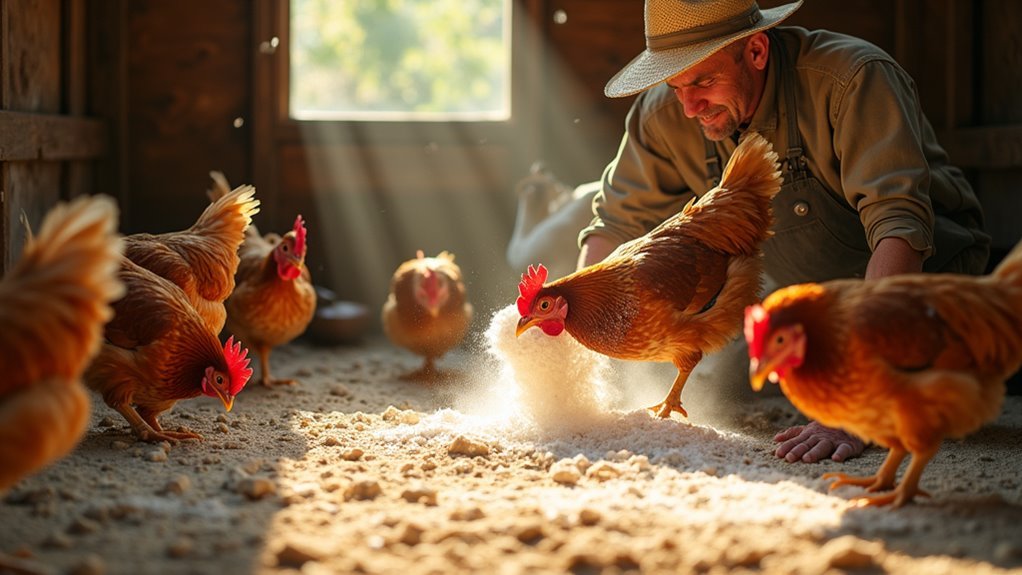
Diatomaceous Earth, or DE, is a natural powder created from the fossilized remains of tiny aquatic organisms called diatoms. This natural substance contains 80-90% silica, giving it unique pest-control properties.
When you apply diatomaceous earth in your chicken coop, it works by physically damaging pests’ exoskeletons through microscopic sharp edges, causing dehydration and death.
Food Grade DE is the only safe option for poultry areas, as it contains amorphous silica rather than harmful crystalline silica. This makes it non-toxic and FDA-recognized as safe around chickens.
Food Grade DE contains safe amorphous silica, making it FDA-recognized as non-toxic for use around chickens and poultry areas.
DE effectively controls external parasites like mites and lice without using chemical pesticides. The powder’s mechanical action targets these unwanted visitors while remaining harmless to your flock when properly applied.
Food-Grade Vs Pool-Grade: Choosing the Right Type for Your Coop
When it comes to protecting your chickens, not all diatomaceous earth is created equal. You must choose food grade diatomaceous earth for your chicken coop, as it’s composed mainly of amorphous silica and meets food chemical codex standards.
This type is completely safe for your birds and provides effective pest control against mites and lice.
Pool grade DE is dangerous and should never be used around animals. It’s super-heated during production, creating high levels of crystalline silica that pose serious health risks. This type is designed solely for pool filtration.
Always check labels carefully to verify you’re purchasing food-grade DE that’s free from harmful additives.
This natural solution protects your chickens while remaining safe for humans, wildlife, and the environment.
Safety Precautions When Handling Diatomaceous Earth
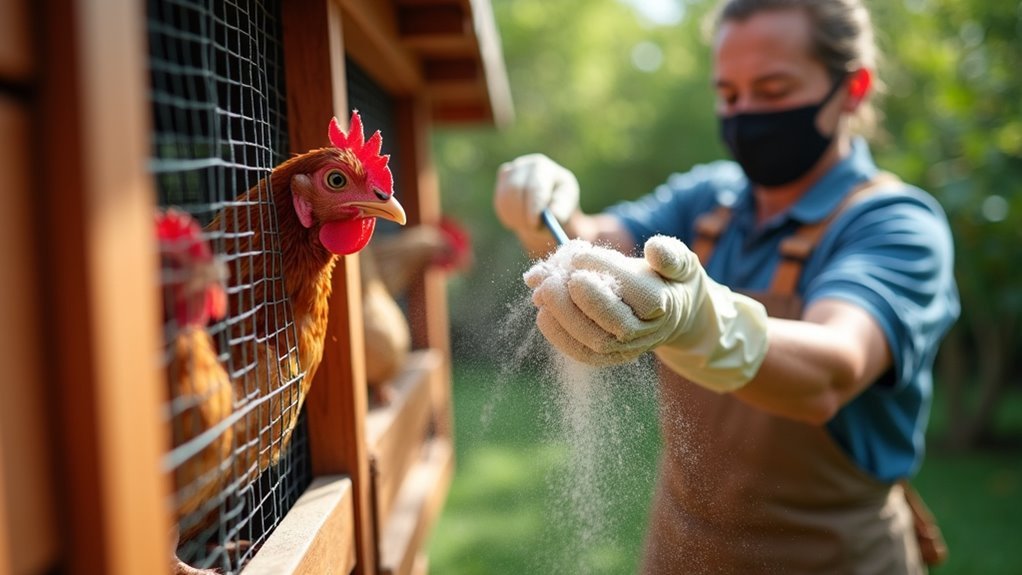
Proper handling protects both you and your chickens from potential health risks. Always use food grade diatomaceous earth, as pool-grade varieties contain crystalline silica that causes respiratory issues.
Wear a dust mask and protective eyewear when applying diatomaceous earth to prevent inhaling fine particles that irritate your lungs and eyes. Choose well-ventilated areas for application and avoid windy conditions to minimize dust exposure.
Store DE in cool, dry locations away from moisture, keeping it out of children’s and pets’ reach to prevent accidental ingestion.
Monitor your chickens for skin dryness or irritation when using DE topically. These safety precautions guarantee you’re protecting yourself while effectively treating your coop.
Adjust application frequency if you notice excessive dryness on your birds’ skin.
Preparing Your Chicken Coop for DE Application
Before you can effectively use diatomaceous earth in your chicken coop, you’ll need to start with a completely clean slate. Remove all old bedding, droppings, and debris from every surface. This thorough cleaning guarantees maximum DE effectiveness against pests.
Once clean, you can apply DE to all surfaces including nesting boxes, roosts, and areas around feeders and water fountains. Pay special attention to cracks and crevices where mites and lice hide during regular cleaning.
Always wear a dust mask during application to minimize respiratory irritation.
Consider integrating DE into your chickens’ dust baths, allowing them to self-treat for external parasites naturally.
To maintain ongoing protection, you’ll need to reapply DE every four weeks or more frequently during high pest seasons.
Step-by-Step Application Methods for Coop Floors and Surfaces
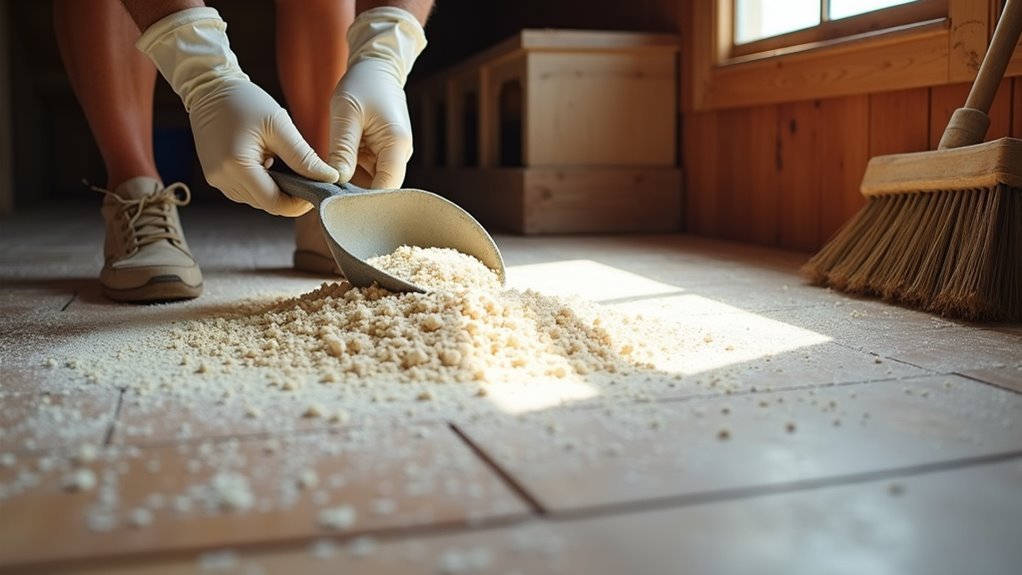
Three essential tools will make your DE application process more effective and even: a fine mesh sifter, a handheld duster, or a dedicated DE applicator.
Begin by focusing on high-traffic areas where pests typically congregate, including corners, roosting areas, and nesting boxes. Apply DE using smooth, sweeping motions to create a thin, uniform layer across coop floors and surfaces.
Don’t forget to treat areas around feeders and waterers where mites often hide. Create designated dust baths by mixing diatomaceous earth with sand or dry dirt in shallow containers.
Pay special attention to cracks and crevices where parasites breed. This systematic approach guarantees thorough pest control throughout your chicken coop while maintaining proper coverage for maximum effectiveness.
Creating Effective Dust Bath Areas With Diatomaceous Earth
While systematically treating your coop surfaces forms the foundation of pest control, establishing dedicated dust bath stations creates an ongoing defense system that empowers your chickens to maintain their own parasite protection.
Mix Diatomaceous Earth with sand or potting compost using a 50-50 ratio in shallow containers. This combination provides the perfect abrasive medium for effective bathing while preventing respiratory issues from excessive dust.
Create a balanced 50-50 blend of Diatomaceous Earth with sand or compost for optimal dust bathing without respiratory concerns.
Position your dust bath in sunny, dry locations within the coop or run where chickens naturally prefer to bathe. The warm conditions maximize DE’s effectiveness against mites and lice.
Check the mixture weekly and refresh as needed, since moisture diminishes pest control properties. This proactive approach helps your flock combat parasites while promoting healthier feathers and reducing skin irritations.
Targeting Specific Pest Problem Areas in Your Coop
You’ll find pests congregating in predictable locations throughout your coop, making targeted DE application more effective than random dusting.
Focus your efforts on common hiding spots like cracks in walls, corners of nesting boxes, and gaps around roosts where mites and lice establish their colonies.
High-traffic zones such as areas around feeders, water fountains, and entrance points also require consistent DE treatment since these locations attract both chickens and parasites.
Common Coop Hiding Spots
Although pests can infiltrate any area of your chicken coop, they consistently target specific hiding spots where they’ll find ideal conditions for survival and reproduction.
Common hiding spots in chicken coops include nesting boxes, roosts, and corners where debris accumulates. You’ll want to apply diatomaceous earth thoroughly in these prime locations where pests establish themselves.
Focus on dusting cracks and crevices around roosting areas, as mites and lice prefer these tight spaces.
Don’t overlook areas under bedding and inside dust baths where parasites often linger undetected. Pay special attention to spaces around feeders and water fountains, since food particles and moisture create attractive environments for various pests.
Remember to reapply DE after each cleaning session to maintain consistent protection in these high-risk zones.
High-Traffic Pest Zones
Since certain areas of your coop experience heavy pest activity, targeting these high-traffic pest zones with diatomaceous earth becomes essential for effective parasite control.
Focus primarily on nesting boxes and roosting areas where external parasites like mites and lice concentrate. These locations provide ideal breeding conditions due to constant chicken contact and warmth.
Apply DE around feeders and water fountains where pests gather, attracted to food sources and moisture.
After cleaning out old bedding, dust the floors thoroughly to eliminate existing pest populations. Pay special attention to cracks and crevices where parasites hide and reproduce.
Establish a consistent dusting schedule every two weeks for these high-traffic areas. This regular application maintains an effective protective barrier against infestations.
Application Frequency and Timing for Maximum Effectiveness
When establishing diatomaceous earth protection in your chicken coop, you’ll need to dust the area twice weekly for the first two weeks to create an effective barrier against mites, lice, and other external parasites. This application frequency guarantees thorough coverage and establishes proper pest control.
After initial treatment, maintain effectiveness by reapplying every four weeks. Apply DE during evening hours when chickens are less active, allowing dust to settle undisturbed on surfaces.
| Application Phase | Frequency |
|---|---|
| Initial Treatment | Twice weekly for 2 weeks |
| Maintenance | Every 4 weeks |
| Active Infestation | Increase frequency as needed |
| Evening Application | Ideal timing for settling |
Monitor regularly for pest infestations and adjust accordingly. Use a DE applicator for even distribution while minimizing dust inhalation during application.
Monitoring Your Flock’s Health During DE Treatment
How can you guarantee your chickens remain healthy throughout diatomaceous earth treatment? Start monitoring your flock immediately after application.
Watch for respiratory distress signs like mouth breathing or coughing, as DE’s fine dust can irritate sensitive birds’ lungs. Check feather condition and overall activity levels regularly—effective treatment should improve both while reducing mites and lice presence.
Monitor chickens closely for breathing difficulties and coughing, as diatomaceous earth dust may irritate sensitive respiratory systems.
Track egg production rates closely. Consistent output indicates good health, while significant drops may signal stress or health issues.
Observe your chickens’ behavior changes; increased dust bathing is normal and beneficial for pest removal and feather maintenance.
Document all health and behavior changes during treatment. This record helps you assess DE’s effectiveness and adjust your management practices for future applications.
Combining DE With Other Natural Pest Control Strategies
You’ll maximize DE’s effectiveness by pairing it with complementary natural pest control methods that address different aspects of pest management.
Herbal deterrents like peppermint and lavender oils create scent barriers that repel insects, while DE provides the physical killing action once pests breach those defenses.
You can also introduce beneficial predators that target pest larvae and eggs, creating a multi-layered defense system that keeps your coop protected year-round.
Herbal Deterrents and DE
While diatomaceous earth effectively combats external parasites on its own, combining it with aromatic herbs like lavender, mint, and rosemary creates a powerful dual-action pest control system for your chicken coop. This natural product combination enhances DE’s effectiveness while providing stress-reducing aromatherapy for your flock.
Mix powdered herbs directly into your chickens dust bath areas to attract birds to the beneficial blend. Sprinkle this herbal deterrents mixture in nesting boxes and roosting areas for thorough protection.
| Application Area | Herb + DE Benefits |
|---|---|
| Dust Bath | Attracts chickens, maximizes exposure |
| Nesting Boxes | Dual-action barrier, soothing aroma |
| Roosting Areas | Continuous pest deterrence |
| Coop Corners | Thorough coverage |
| Entry Points | Natural pest prevention |
This sustainable approach reduces synthetic chemical dependence while promoting holistic chicken health.
Beneficial Predator Integration
Beyond herbal combinations, you can amplify DE’s pest control power by welcoming beneficial predators into your chicken coop ecosystem.
Integrate ladybugs and lacewings that naturally hunt aphids and mites threatening your flock’s health. These beneficial insects work alongside Diatomaceous Earth to create a balanced, self-regulating environment.
You’ll establish dual-action protection when you dust DE in nesting boxes and roosts while these predators patrol for live pests. The beneficial insects handle active hunting while DE physically damages crawling pests through abrasion.
This combination reduces your reliance on chemical pesticides, creating a healthier chicken coop environment.
Monitor your beneficial predator populations regularly to assess effectiveness.
You’re building sustainable pest control that protects your chickens while maintaining ecological balance through natural predator-prey relationships.
Frequently Asked Questions
How to Apply Diatomaceous Earth in Chicken Coop?
You’ll clean out old bedding first, then dust DE evenly on floors, nesting boxes, and roosts using an applicator. Apply directly on chickens’ bodies, focusing on vent areas and under wings while wearing protection.
How Do I Pest Proof My Chicken Coop?
Pest-proof your coop by maintaining clean bedding, ensuring proper ventilation, and sealing cracks where pests enter. Install hardware cloth over openings, remove food spillage promptly, and create designated dust bath areas for natural pest control.
How Much De to Put in a Chicken Coop?
You’ll want to use 1-2 cups of food-grade DE per 100 square feet of coop space. Dust nesting boxes and roosts lightly, then reapply every 2-4 weeks for effective pest control.
How Often Should I Sprinkle De in Chicken Coop?
You should sprinkle DE every two weeks for peak effectiveness. Apply it for two consecutive weeks initially, then maintain with applications every four weeks. Dust during evening or early morning when chickens aren’t active.
In Summary
You’ve now got the knowledge to protect your coop using diatomaceous earth effectively. Remember to always choose food-grade DE, wear protective gear during application, and monitor your flock’s health regularly. Don’t rely on DE alone—combine it with other natural pest control methods for best results. With consistent application every few weeks and proper targeting of problem areas, you’ll maintain a healthier, pest-free environment for your chickens.

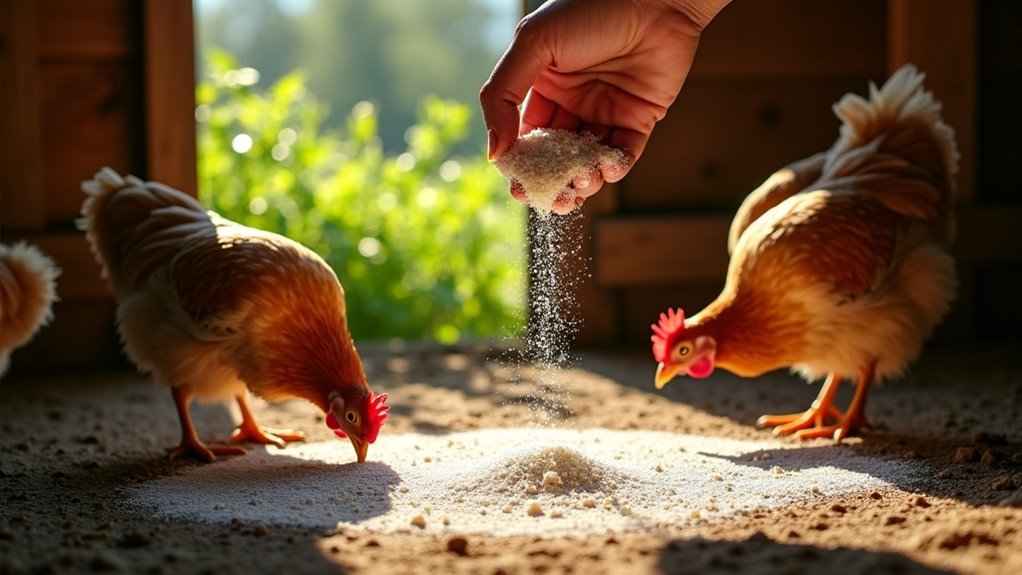

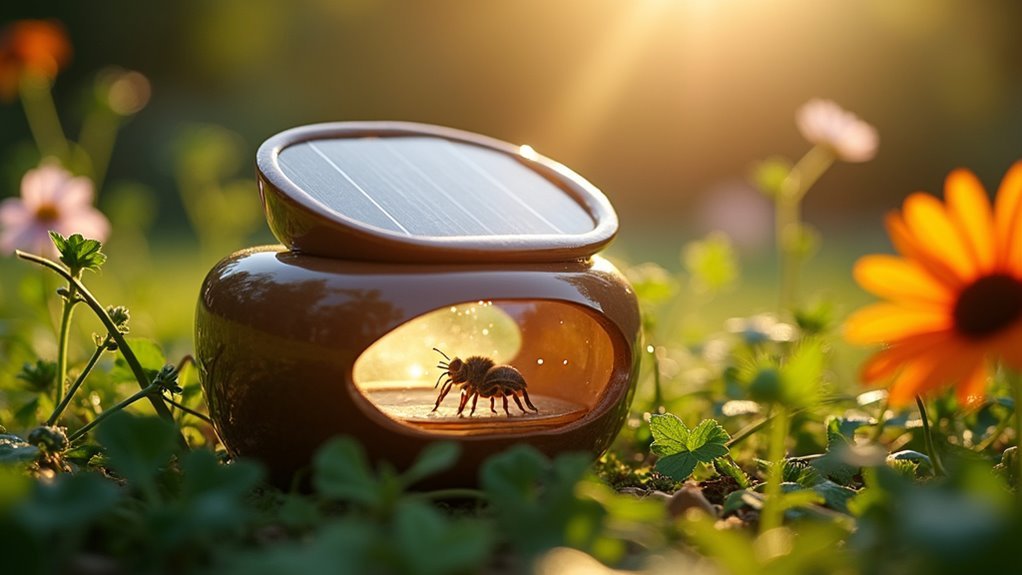

Leave a Reply